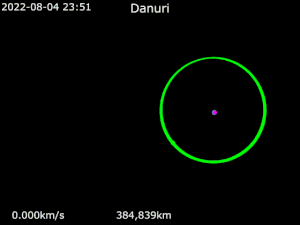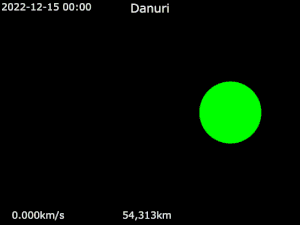Danuri
 A rendered image of KPLO | |
| Names | KPLO |
|---|---|
| Mission type | Lunar orbiter |
| Operator | Korea Aerospace Research Institute(KARI) |
| COSPAR ID | 2022-094A |
| SATCATno. | 53365 |
| Website | www |
| Mission duration | 711 days, 5 hours and 8 minutes (elapsed) |
| Spacecraft properties | |
| Manufacturer | Korea Aerospace Research Institute(KARI) |
| Launch mass | 678 kg (1,495 lb)[1][2] |
| Dry mass | c. 550 kg (1,210 lb)[3] |
| Payload mass | 40 kg (88 lb) |
| Power | 760watts[4] |
| Start of mission | |
| Launch date | 4 August 2022, 23:08:48UTC[5] |
| Rocket | Falcon 9 Block 5 |
| Launch site | Cape Canaveral (CCSFS), SLC-40 |
| Contractor | SpaceX |
| Moonorbiter | |
| Orbital insertion | 17 December 2022KST(1st) 28 December 2022 KST (5th)[6] |
| Orbital parameters | |
| Periselene altitude | 100 km[6] |
| Aposelene altitude | 100 km |
| Inclination | 90° (polar) |
| Transponders | |
| Band | S-band,X-band[4][7] |
| Instruments | |
| Lunar Terrain Imager (LUTI) Wide-Angle Polarimetric Camera (PolCam) KPLO Magnetometer (KMAG) KPLO Gamma Ray Spectrometer (KGRS) Delay-Tolerant Networking experiment (DTNPL) ShadowCam (NASA) | |
TheKorea Pathfinder Lunar Orbiter(KPLO), officiallyDanuri,[8]is South Korea's first lunar orbiter. The orbiter, its science payload and ground control infrastructure are technology demonstrators. The orbiter will also be tasked with surveyinglunar resourcessuch aswater ice,uranium,helium-3,silicon,andaluminium,and produce a topographic map to help select future lunar landing sites.
The mission was launched on 4 August 2022 on aFalcon 9 Block 5launch vehicle.[5]It was inserted into orbit around the Moon on 16 December 2022 (UTC).[9]
Name[edit]
On 23 May 2022, the South KoreanMinistry of Science and ICTofficially named the Korea Pathfinder Lunar Orbiter (시험용 달 궤도선, thí nghiệm dùng nguyệt quỹ đạo thuyền ) as "Danuri" (다누리). Danuri is aportmanteauof two Korean words,dal(달) which means moon andnurida(누리다) which means enjoy. According to the ministry, this new name implies a big hope and desire for the success of South Korea's first Moon mission.[10]
Overview[edit]
South Korea's space agency, calledKorea Aerospace Research Institute(KARI), together withNASAproduced a lunar orbiter feasibility study in July 2014.[11]The two agencies signed an agreement in December 2016 where NASA will collaborate with one science instrument payload, telecommunications, navigation, and mission design.[12][13][14]
The Korean Lunar Exploration Program (KLEP) is divided in two phases.[13][15]Phase 1 is the launch and operation of KPLO, which is the first lunar probe by South Korea,[12]meant to develop and enhance South Korea's technological capabilities, as well as map natural resources from orbit. The key goals of the KPLO orbiter mission include investigation of lunar geology and space environment, exploration of lunar resources, and testing of future space technology which will assist in future human activities on the Moon and beyond.
Phase 2 will include a lunar orbiter, alunar lander,and a 20 kgrover,[16]to be launched together on a KSLV-3[1]South Korean launch vehicle from theNaro Space Center,[14][15]by 2032.[17][18]
Objectives[edit]
The main objectives of this mission are to enhance the South Korean technological capabilities on the ground and inouter space,and to "increase both the national brand value and national pride".[19]The specific technological objectives are:[7]
- Development of critical technologies for lunar exploration.
- Produce a topographic map for support to select future lunar landing sites, and to survey lunar resources such aswater ice,uranium,helium-3,silicon,andaluminium.
- Development and validation of newspace technologies.
From the lunar science perspective, understanding the water cycle on theMoonis critical to mapping and exploitation.[20]Solar windprotonscan chemically reduce the abundantiron oxidespresent the lunar soil, producing native metal iron (Fe0) and ahydroxylion (OH−) that can readily capture aprotonto form water (H2O). Hydroxyl and water molecules are thought to be transported throughout the lunar surface by mysterious unknown mechanisms, and they seem to accumulate at permanently shadowed areas that offer protection from heat and solar radiation.[20]
Space Internet[edit]
To test the experimental system of the “space Internet”,Danuri successfully forwarded a number of photos taken, as well as several video files, including,BTS’“Dynamite”from outer space to Earth at Korea'sMinistry of Science and ICT,Korea Aerospace Research Institute(KARI), and theElectronics and Telecommunications Research Institute(ETRI) on 7 November 2022.[21][22]
Science payload[edit]
KPLO carries six science instruments with a total mass of approximately 40 kg (88 lb).[7]Five instruments are from South Korea and one from NASA:[23][14][20]
- Lunar Terrain Imager (LUTI)will take images of probable landing sites for the second stage lunar exploration mission and special target sites of the lunar surfaces with a high spatial resolution (<5 m).
- Wide-Angle Polarimetric Camera (PolCam)will acquire thepolarimetric imagesof the entire lunar surface except for the polar regions with medium spatial resolution in order to investigate the detailed characteristics oflunar regolith.
- KPLO Magnetometer (KMAG)is amagnetometerthat will measure the magnetic strength of the lunar environment (up to ~100 km above the lunar surface) with ultra-sensitive magnetic sensors.
- KPLO Gamma Ray Spectrometer (KGRS)is agamma-ray spectrometerthat will investigate the chemical composition of lunar surface materials within a gamma-ray energy range from 10keVto 10 MeV, and map their spatial distribution.[3][24]
- Delay-Tolerant Networking experiment (DTNPL)will perform a communication experiment ondelay-tolerant networking(DTN), a type ofinterplanetary Internetfor communication with landed assets.[7]
- NASA'sShadowCamwill map the reflectance within the permanently shadowed regions to search for evidence ofwater ice deposits.[25]
ShadowCam[edit]
ShadowCam is a hypersensitive optical camera that will collect images of permanently shadowed regions (PSRs) near the Moon's poles. This will allow ShadowCam to map the reflectance of these regions to search for evidence of ice deposits, observe seasonal changes, and measure the terrain inside the craters.[26]The instrument is based on theLunar Reconnaissance OrbiterLROC narrow angle camera (NAC), but it is 200 times more sensitive[27]to allow for capturing details within the permanently shadowed regions. ShadowCam was developed by scientists atArizona State UniversityandMalin Space Science Systems.[28]

Science objectives of the ShadowCam experiment:[30][31]
- Map albedo patterns in PSRs and interpret their nature
- ShadowCam will search for frost, ice, and lag deposits by mapping reflectance with resolution and signal-to-noise ratios comparable to LROC NAC images of illuminated terrain.
- Investigate the origin of anomalous radar signatures associated with some polar craters
- ShadowCam will determine whether high-purity ice or rocky deposits are present inside PSRs.
- Document and interpret temporal changes of PSR albedo units
- ShadowCam will search for seasonal changes in volatile abundance in PSRs by acquiring monthly observations.
- Provide hazard and trafficability information within PSRs for future landed elements
- ShadowCam will provide optimal terrain information necessary for polar exploration.
- Map the morphology of PSRs to search for and characterize landforms that may be indicative of permafrost-like processes
- ShadowCam will provide unprecedented images of PSR geomorphology at scales that enable detailed comparisons with terrain anywhere on the Moon.
Launch[edit]
Originally planned for a December 2018 launch,[14][28]KPLO was placed into orbit by aFalcon 9launch vehicle on 4 August 2022.[5]Because Danuri was launched as a dedicatedFalcon 9mission, the payload along with Falcon 9's second stage was placed directly on an Earth escape trajectory and intoheliocentric orbitwhen the second stage reignited for a second engine startup or escape burn.

As KPLO usesballistic lunar transfer(BLT) to transfer to a Moon orbit, it took the spacecraft about 135 days to reach the Moon, with alunar-orbit insertionon 16 December 2022 (UTC).[32][9]After insertion, the spacecraft will conduct a set of phasing-burns to reduce the orbit's eccentricity from elliptic to circular, reaching low-lunar orbit. This was a change of plan from the previous one, where the orbiter would have performed at least three highly elliptical orbits ofEarth,each time increasing its velocity and altitude until it reachesescape velocity,initiating atrans-lunar injection.[14][33]
The spacecraft's main propulsion is from four 30-newtonthrusters, and forattitude control(orientation) it uses four 5-newton thrusters.[7][14]
See also[edit]
References[edit]
- ^Kang, Il-yong (17 May 2022)."[K-스페이스 시대] ② 한국 최초 달 탐사선 오는 8월 발사...7번째 달 탐사국 이름 올린다"[[K-Space Era] ② Korea's first lunar probe to be launched in August... 7th lunar probe to be named].Aju Business Daily(in Korean).Retrieved22 May2022.
- ^Clark, Stephen (20 September 2019)."Launch of South Korean lunar orbiter delayed to 2022".Spaceflight Now.Retrieved27 September2020.
- ^abIntroduction to the lunar gamma-ray spectrometer for Korea Pathfinder Lunar OrbiterKim, Kyeong; Min, Kyoung Wook; et al. 42nd COSPAR Scientific Assembly July 2018; Bibcode: 2018cosp...42E1755K
- ^ab"Korea Pathfinder Lunar Orbiter (KPLO)".NASA. 10 February 2021.Retrieved27 February2021.
 This article incorporates text from this source, which is in thepublic domain.
This article incorporates text from this source, which is in thepublic domain.
- ^abcS.Korean Spaceflight [@KOR_Spaceflight] (28 July 2022)."Danuri(KPLO) launch now scheduled for August 5th 08:08 KST, according to MSIT/KARI"(Tweet) – viaTwitter.
- ^ab"다누리, 달 임무궤도 진입 시작"[Danuri begins entering lunar mission orbit]. Ministry of Science and ICT. 15 December 2022.
- ^abcdeKorean Pathfinder Lunar Orbiter (KPLO) Status UpdateKorea Aerospace Research Institute (KARI) 10 October 2017
- ^Kan, Hyeong-woo (23 May 2022)."Korea's first lunar mission named 'Danuri'".The Korea Herald.Retrieved26 May2022.
- ^ab"South Korea's 1st moon probe Danuri begins to enter lunar orbit".Space.17 December 2022.
- ^Hyeong-woo, Kan (23 May 2022)."Korea's first lunar mission named 'Danuri'".The Korea Herald.Retrieved23 May2022.
- ^"Opening of a New Chapter for Korea-US Space Cooperation" Signing of Korea-US Lunar Probe Implementation AgreementKorea Aerospace Research Institute (KARI) 31 December 2016
- ^abKPLOLunar Exploration ProgramKorea Aerospace Research Institute(KARI) Accessed on 25 January 2019
- ^abSpaceX selected to assist 2020 South Korean lunar orbiter voyageLee Keun-young,Hankyoreh30 December 2017
- ^abcdefSouth Korea's first lunar mission planned for 2020Emily Lakdawalla,The Planetary Society7 December 2017
- ^abKorean Lunar Exploration ProgramKorean Aerospace Research Institute (KARI) Accessed on 25 January 2019
- ^Kim, K.; Wohler, C.; Hyeok Ju, G.; Lee, S.; Rodriguez, A.; Berezhnoy, A.; Gasselt, S.; Grumpe, A.; and Aymaz, R.; (2016) Korean lunar lander – Concept study for landing-site selection for lunar resource exploration. The International Archives Of The Photogrammetry, Remote Sensing And Spatial Information Sciences, Vol XLI-B4, pp 417–423 (2016), 417. doi:10.5194/isprs-archives-XLI-B4-417-2016
- ^Pak, Han-pyol (1 July 2013)."핵전지 실은 한국형 로버… 지구서 우주인터넷 통해 조종".JoongAng Ilbo.Retrieved19 July2013.
- ^Kim, Jack (20 November 2007)."South Korea eyes moon orbiter in 2020, landing 2025".Reuters.Retrieved25 January2019.
- ^Prospective of Korean space project, Lunar Exploration.Korea Aerospace Research Institute(KARI), South Korea. Accessed on 25 January 2019.
- ^abcSouth Korea's 2018 Lunar Mission.Paul D. Spudis,Air and Space Magazine.26 September 2016.
- ^"The South Korean probe" Danuri "sent a music video of the BTS group".17 November 2022.
- ^우주에서 보내온 BTS 다이너마이트 뮤직비디오ㅣ다누리 우주 인터넷 탑재체,retrieved18 December2022
- ^Krebs, Gunter (16 March 2020)."KPLO".Gunter's Space Page.Retrieved27 September2020.
- ^Shin, J.; Jin, H.; Lee, H.; Lee, S.; Lee, S.; Lee, M.; Jeong, B.; Lee, J.-K.; Lee, D.; Son, D.; Kim, K.-H.; Garrick-Bethell, I.; Kim, E. (18–22 March 2019).KMAG: The Magnetometer of the Korea Pathfinder Lunar Orbiter (KPLO) Mission(PDF).Lunar and Planetary Science Conference. Universities Space Research Association (USRA).Bibcode:2019LPI....50.2276S.Retrieved27 September2020.
- ^"ShadowCam: Seeing into the Shadow".Arizona State University. 2018.Retrieved27 September2020.
- ^"NASA's ShadowCam Launches Aboard Korea Pathfinder Lunar Orbiter – Artemis".blogs.nasa.gov.4 August 2022.Retrieved6 August2022.
 This article incorporates text from this source, which is in thepublic domain.
This article incorporates text from this source, which is in thepublic domain.
- ^"ShadowCam - Seeing in the Shadows".19 December 2018.
- ^abClark, Stephen (28 April 2017)."U.S. instrument team to fly camera on South Korean moon mission".Spaceflight Now.Retrieved27 September2020.
- ^"ShadowCam • Seeing in the Shadows".shadowcam.sese.asu.edu.Retrieved12 January2023.
- ^"ShadowCam • Seeing in the Shadows".shadowcam.sese.asu.edu.Retrieved6 August2022.
- ^"ShadowCam Factsheet"(PDF).shadowcam.sese.asu.edu.Archived fromthe original(PDF)on 8 August 2022.Retrieved6 August2022.
- ^"다누리호 (KPLO-Korea Pathfinder Lunar Orbiter)".kari.re.kr.Retrieved6 September2022.
- ^"[ home > R&D > Lunar Exploration > Korea's first step toward lunar exploration ]".kari.re.kr.Retrieved29 June2022.





